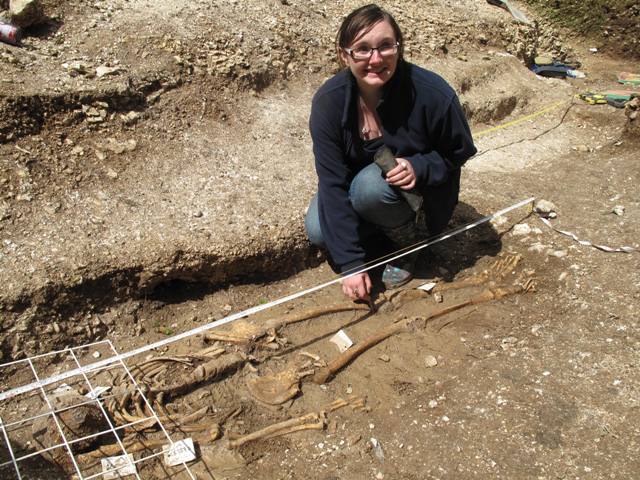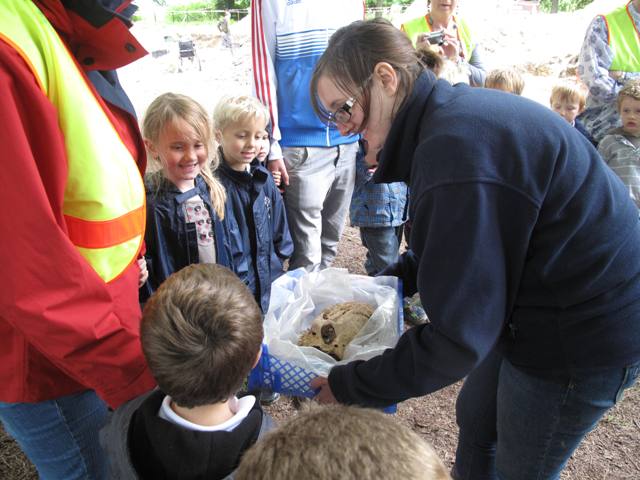Today’s blog has been written by Stef, an osteoarchaeologist (specialist in human remains) volunteering on Operation Nightingale, about one of the Saxon burials she has been excavating:
I am a commercial osteoarchaeologist and have spent several years working on archaeological sites and analysing human remains in the lab. I first heard about Operation Nightingale from a friend and since I knew there were likely to be burials found at Barrow Clump I asked if it would be useful if I helped out.
I have spent the last few days working with Mike excavating a grave which included several small finds. We first uncovered the edges of the grave then slowly worked down to the level of the skeleton. Once the outline of the skeleton was visible we used small tools and brushes to uncover each bone, before planning, photographing and carefully removing the skeleton.
One of the first things to be uncovered was a shield boss, a circular metal object which would have formed the centre of a wooden shield. Along with this we found iron fittings from the outside rim of the shield and objects which may have formed part of a belt, along with a short knife blade.
While these objects can tell us a lot about the material culture of the time period and population there is also a great deal of information which can be gained from studying the skeleton. This is best done in a lab once the bones have been properly washed and laid out but there are some techniques which can be applied in the field.
The skull of the skeleton was intact which allows us to establish the sex of the individual. This skeleton was male which is evident from the large brow ridge above the eyes, the large and rough muscle attachments at the back of the skull and the large mastoid processes (an area just behind the ear which is an attachment site for muscles from the neck). Another area we use to tell the sex of skeletons is the pelvis, which is adapted for child birth in females. Unfortunately the pelvis was mostly destroyed in this burial so having the whole skull was very helpful.
We were also able to give an approximate age to the skeleton by looking at the fusion of the bones. The bones of children start off as several smaller parts which gradually fuse into one as they get older. The bones of this individual were completely fused; studies have shown that the end of the collar bone fuses from the age of 23 so we can say this individual is at least that old.
We also looked at the wear of the molar teeth of the individual to give and indication of age: this technique works on the basis that small pieces of grit would have been present in food from grinding corn and other similar methods of food preparation. This wears down the teeth over the life of the individual. A quick look at the teeth of the lower jaw indicates this individual was in his early to mid thirties. Once the skeleton is cleaned and in the lab we may be able to use additional techniques to confirm his age. It might also be possible to find out if he suffered from any illnesses or injuries during his lifetime.
The skeletons can also be tested for clues on where the individuals came from. This technique known as isotopic analysis works by examining the chemical makeup of teeth. Teeth form very early in an individual’s life and the chemical content of tooth enamel is affected by the type of water drunk early in life; e.g. water which has come from a chalky area has a different chemical signature than water which has come from a granite area. Isotopic analysis would allow us to find out if the individuals buried at Barrow Clump were born in the area or had travelled a long way before they were buried here.
The chance to join the excavations with Operation Nightingale has been a great experience for me and has allowed me to experience some amazing archaeology. I have really enjoyed working with the soldiers and have been impressed with the amount of skills which archaeology and the army share; not something I had realised before. I am really glad I was able to be involved in the project which I think has given everyone involved a great experience.
To return to the main Project Florence blog, www.florence.opnightingale.co.uk/blog, click here.

